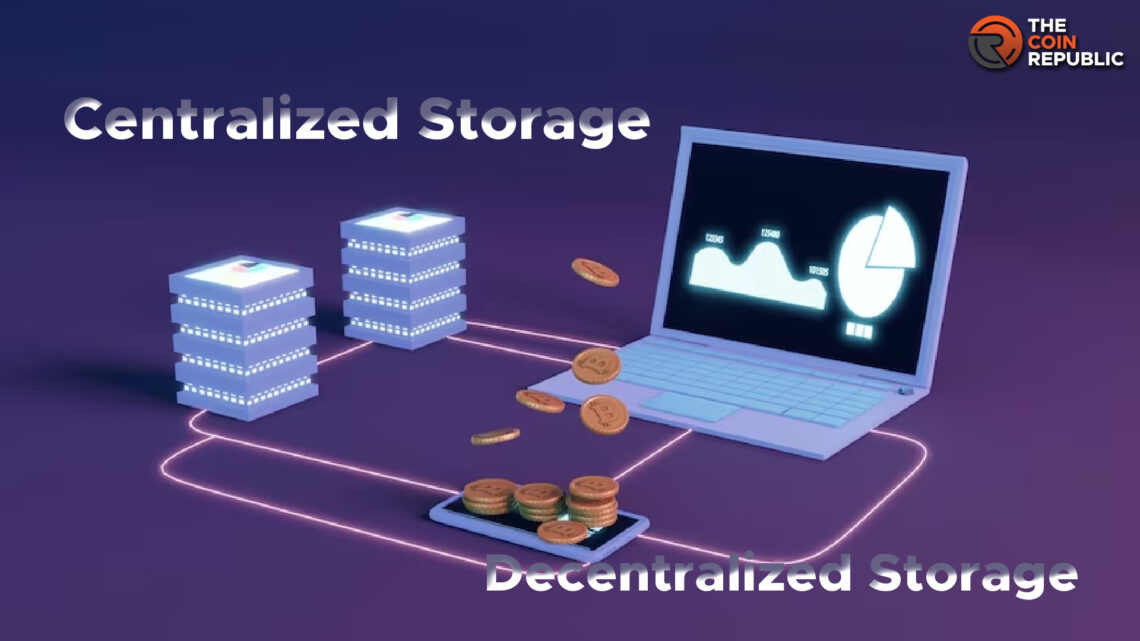- 1 Centralized vs. decentralized storage involves trade-offs based on control, resilience, and features.
- 2 Centralization offers speed, while decentralization adds security with redundancy and control.
- 3 A balanced approach could leverage the benefits of both centralized and decentralized storage.
Individuals and organizations typically choose between two major options: centralized storage and decentralized storage. Given that both approaches have advantages and disadvantages, studying the key differences between the two is important to make an informed decision about which storage solutions to rely on and the priorities of each.
Centralized Data Storage
Centralized storage means your data is stored in systems controlled by a single entity, With centralized storage, all user data is uploaded and stored on servers fully controlled by the storage service provider. The provider has complete decision power over the location of data centers, the choice of hardware and software, and the policies surrounding data management, processing, and security within their closed ecosystem.
Benefits of Centralized Storage
Centralized storage is easy to use. The average user only needs a few technical skills. The provider handles the complex backend. Users just sign up, get the app, and upload files smoothly.
Centralized providers can build many features. These make storage easier and better. For example, they have real-time sharing, version history, recycle bins, etc. Users get a lot of great storage features.
Centralized providers control their servers fully. This lets them add strong security measures. These include firewalls, encryption, access logs, etc. They can also control who has access to accounts.
Centralized providers have large data centers. This lets them save on costs due to scale. They can offer more storage for less money. This helps average and small users.
Centralized networks that aim for fast speeds. They want low latency and high uptime. They have many backups to avoid data loss. This gives users reliable access at all times.
Limitations of Centralized Storage Solutions
However, centralized storage also comes with some limitations, which are as follows:
- Centralized storage puts all data in one place. If that place fails, all data becomes unavailable. This single point can fail. Then users cannot access their data.
- Users have no control over centralized storage. The provider fully manages the data. Users cannot decide where or how data is stored. They must accept the provider’s policies.
- The centralized provider can access all user data. Users must trust them not to misuse their data. But central storage is an attractive target for hacking and attacks.
- Providers may restrict or censor user data. They may do this for business reasons. This goes against data ownership principles. Users may lose access to their own data.
- Once data is stored centrally, it is hard to move. Users are locked into the service. High costs and effort to switch providers. This limits the user’s flexibility.
Decentralized Data Storage
Decentralized storage works differently than centralized storage. The data is split into encrypted pieces. These small pieces are spread out across many computers on a peer-to-peer network. Many different users run these computers. All the computers together make a huge and tough storage pool. Data is not kept in one central place. It is split and scattered among many decentralized computer nodes. This makes the storage decentralized. The nodes cooperate as peers to hold the data.
Prominent examples of decentralized storage networks include blockchain-based protocols like Filecoin, Sia, and Storj, and technologies like Open Stack Swift, Dat, and InterPlanetary File System (IPFS).
How Decentralized Storage Works
In decentralized storage networks, when a user wishes to upload data:
1. The data is encrypted, split into fragments, and distributed randomly among nodes on the network.
2. Nodes accepting data fragments are financially incentivized to provide storage capacity and maintain uptime.
3. Manifests of data fragment locations are recorded in a ledger to retain indexing and enable retrieval.
4. When the original data needs to be accessed again, fragments are re-assembled by retrieving them from the distributed node locations.
Benefits of Decentralized Storage
Decentralized storage offers several advantages:
- If one node fails, data from other nodes is still available. This removes the single point of failure risk. Decentralized storage is more resilient.
- Data is duplicated across many nodes redundantly. All data fragments would need to be lost to lose data. This prevents permanent data loss.
- The data is encrypted and split into random pieces. This makes breaches much harder. Users keep more control over security.
- No single entity controls the data. This avoids censorship risks. Decentralized data can resist censorship.
- Users do not rely on any one storage provider. The data is spread across many nodes. This prevents vendor lock-in effects.
- Trust increases with decentralization. Consensus secures data, not any provider. Users need not inherently trust storage providers.
Limitations of Decentralized Storage
However, decentralized storage also has some key limitations:
Decentralized storage is often slower than centralized networks. Breaking up and duplicating data causes more latency. Consensus mechanisms also slow things down. Speed is worse compared to centralized.
The average user may find decentralized storage more complex. It requires more technical skills to use and manage. Onboarding is trickier than centralized options.
Decentralized storage has fewer features right now. The technology is still relatively new. Centralized services have had more time to build advanced features.
Nodes in decentralized networks need incentives to provide storage. Token rewards or payments incentivize nodes. However, these models are complex to design.
Data is duplicated across nodes for redundancy. But this lowers the storage density per node. Dense storage is less costly.
There is regulatory uncertainty around decentralized networks. Taxation, reporting, and compliance needs are unclear. More regulatory clarity is needed.
Key Differences Between Centralized and Decentralized Storage
Some of the key differences between centralized and decentralized storages solution are:
1. Control
Centralized storage concentrates control and oversight in a single storage provider. Decentralized storage spreads control across a multi-party peer-to-peer network.
2. Failure Resistance
Centralized storage has a single point of failure. Decentralized storage offers higher resistance to outages and data loss.
3. Trust Requirements
Centralized storage requires users to trust the storage provider. Decentralized storage removes this need for trust in any single entity.
4. Features
Centralized storage has more refined and user-friendly features. Decentralized storage features are more basic currently.
5. Performance
Centralized storage offers lower latency, higher speeds, and more bandwidth. Decentralized storage has slower performance currently.
6. Security
Both offer encryption capabilities. However, decentralization further secures data via distribution across nodes.
There is no best data storage solution for everything. The best choice depends on your needs and priorities. For individuals, centralized is simpler and has more features. However, for large companies, decentralization provides more security.
Centralized is better if speed matters most. But decentralization is when censorship risks are high. A hybrid approach can balance the trade-offs. As decentralized technology matures, it can complement or disrupt centralized storage. Centralized will likely retain advantages in usability and cost. The optimal data storage solution depends on the specific use case and data needs.
Conclusion
In conclusion, by understanding the core differences between centralized and decentralized data storage models, individuals and organizations can make informed choices aligned with their priorities and use case requirements. The data storage landscape will likely evolve toward greater decentralization, though centralized servers will continue to power daily workflows.

With a background in journalism, Ritika Sharma has worked with many reputed media firms focusing on general news such as politics and crime. She joined The Coin Republic as a reporter for crypto, and found a great passion for cryptocurrency, Web3, NFTs and other digital assets. She spends a lot of time researching and delving deeper into these concepts around the clock, and is a strong advocate for women in STEM.


 Home
Home News
News









